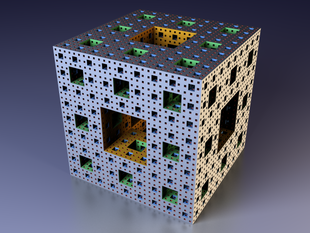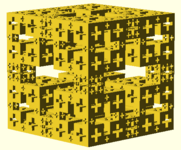Menger sponge

In mathematics, the Menger sponge (also known as the Menger cube, Menger universal curve, Sierpinski cube, or Sierpinski sponge)[1][2][3] is a fractal curve. It is a three-dimensional generalization of the one-dimensional Cantor set and two-dimensional Sierpinski carpet. It was first described by Karl Menger in 1926, in his studies of the concept of topological dimension.[4][5]
Construction[]
The construction of a Menger sponge can be described as follows:
- Begin with a cube.
- Divide every face of the cube into nine squares, like Rubik's Cube. This sub-divides the cube into 27 smaller cubes.
- Remove the smaller cube in the middle of each face, and remove the smaller cube in the very center of the larger cube, leaving 20 smaller cubes. This is a level-1 Menger sponge (resembling a void cube).
- Repeat steps two and three for each of the remaining smaller cubes, and continue to iterate ad infinitum.
The second iteration gives a level-2 sponge, the third iteration gives a level-3 sponge, and so on. The Menger sponge itself is the limit of this process after an infinite number of iterations.

Properties[]
The th stage of the Menger sponge, , is made up of smaller cubes, each with a side length of (1/3)n. The total volume of is thus . The total surface area of is given by the expression .[6][7] Therefore the construction's volume approaches zero while its surface area increases without bound. Yet any chosen surface in the construction will be thoroughly punctured as the construction continues, so that the limit is neither a solid nor a surface; it has a topological dimension of 1 and is accordingly identified as a curve.
Each face of the construction becomes a Sierpinski carpet, and the intersection of the sponge with any diagonal of the cube or any midline of the faces is a Cantor set. The cross section of the sponge through its centroid and perpendicular to a space diagonal is a regular hexagon punctured with hexagrams arranged in six-fold symmetry.[8] The number of these hexagrams, in descending size, is given by , with .[9]
The sponge's Hausdorff dimension is log 20/log 3 ≅ 2.727. The Lebesgue covering dimension of the Menger sponge is one, the same as any curve. Menger showed, in the 1926 construction, that the sponge is a universal curve, in that every curve is homeomorphic to a subset of the Menger sponge, where a curve means any compact metric space of Lebesgue covering dimension one; this includes trees and graphs with an arbitrary countable number of edges, vertices and closed loops, connected in arbitrary ways. In a similar way, the Sierpinski carpet is a universal curve for all curves that can be drawn on the two-dimensional plane. The Menger sponge constructed in three dimensions extends this idea to graphs that are not planar, and might be embedded in any number of dimensions.
The Menger sponge is a closed set; since it is also bounded, the Heine–Borel theorem implies that it is compact. It has Lebesgue measure 0. Because it contains continuous paths, it is an uncountable set.
Experiments also showed that for the same material, cubes with a Menger sponge structure could dissipate shocks five times better than a cubes without any pores.[10]
Formal definition[]
Formally, a Menger sponge can be defined as follows:
where is the unit cube and
MegaMenger[]
MegaMenger was a project aiming to build the largest fractal model, pioneered by Matt Parker of Queen Mary University of London and Laura Taalman of James Madison University. Each small cube is made from six interlocking folded business cards, giving a total of 960 000 for a level-four sponge. The outer surfaces are then covered with paper or cardboard panels printed with a Sierpinski carpet design to be more aesthetically pleasing.[11] In 2014, twenty level-three Menger sponges were constructed, which combined would form a distributed level-four Menger sponge.[12]

One of the MegaMengers, at the University of Bath

A model of a tetrix viewed through the centre of the Cambridge Level-3 MegaMenger at the 2015 Cambridge Science Festival
Similar fractals[]
Jerusalem cube[]
A Jerusalem cube is a fractal object described by Eric Baird in 2011. It is created by recursively drilling Greek cross-shaped holes into a cube.[13][14] The construction is similar to the Menger sponge but with two different-sized cubes. The name comes from a face of the cube resembling a Jerusalem cross pattern.[15]
The construction of the Jerusalem cube can be described as follows:
- Start with a cube.
- Cut a cross through each side of the cube, leaving eight cubes (of rank +1) at the corners of the original cube, as well as twelve smaller cubes (of rank +2) centered on the edges of the original cube between cubes of rank +1.
- Repeat the process on the cubes of rank 1 and 2.
Iterating an infinite number of times results in the Jerusalem cube.
Since the edge-length of a cube of rank N is equal to that of 2 cubes of rank N+1 and a cube of rank N+2, it follows that the scaling factor must satisfy , therefore which means the fractal cannot be constructed on a rational grid.
Since a cube of rank N gets subdivided into 8 cubes of rank N+1 and 12 of rank N+2, the Hausdorff dimension must therefore satisfy . The exact solution is
which is approximately 2.529
As with the Menger sponge, the faces of a Jerusalem cube are fractals[15] with the same scaling factor. In this case the Hausdorff dimension must satisfy . The exact solution is
which is approximately 1.786

Third iteration Jerusalem cube

3D-printed model Jerusalem cube
Others[]

- A Mosely snowflake is a cube-based fractal with corners recursively removed.[16]
- A tetrix is a tetrahedron-based fractal made from four smaller copies, arranged in a tetrahedron.[17]
- A Sierpinski-Menger snowflake is a cube-based fractal in which eight corner cubes and the one central cube are kept each time at the lower and lower recursion steps. This peculiar three dimensional fractal has the Hausdorff dimension of the natively two dimensional object like the plane i.e. log 9/log 3=2
See also[]
- Apollonian gasket
- Cantor cube
- Koch snowflake
- Sierpiński tetrahedron
- Sierpiński triangle
- List of fractals by Hausdorff dimension
References[]
- ^ Beck, Christian; Schögl, Friedrich (1995). Thermodynamics of Chaotic Systems: An Introduction. Cambridge University Press. p. 97. ISBN 9780521484510.
- ^ Bunde, Armin; Havlin, Shlomo (2013). Fractals in Science. Springer. p. 7. ISBN 9783642779534.
- ^ Menger, Karl (2013). Reminiscences of the Vienna Circle and the Mathematical Colloquium. Springer Science & Business Media. p. 11. ISBN 9789401111027.
- ^ Menger, Karl (1928), Dimensionstheorie, B.G Teubner Publishers
- ^ Menger, Karl (1926), "Allgemeine Räume und Cartesische Räume. I.", Communications to the Amsterdam Academy of Sciences. English translation reprinted in Edgar, Gerald A., ed. (2004), Classics on fractals, Studies in Nonlinearity, Westview Press. Advanced Book Program, Boulder, CO, ISBN 978-0-8133-4153-8, MR 2049443
- ^ Wolfram Demonstrations Project, Volume and Surface Area of the Menger Sponge
- ^ University of British Columbia Science and Mathematics Education Research Group, Mathematics Geometry: Menger Sponge
- ^ Chang, Kenneth (27 June 2011). "The Mystery of the Menger Sponge". Retrieved 8 May 2017 – via NYTimes.com.
- ^ "A299916 - OEIS". oeis.org. Retrieved 2018-08-02.
- ^ Dattelbaum, Dana M.; Ionita, Axinte; Patterson, Brian M.; Branch, Brittany A.; Kuettner, Lindsey (2020-07-01). "Shockwave dissipation by interface-dominated porous structures". AIP Advances. 10 (7): 075016. doi:10.1063/5.0015179.
- ^ Tim Chartier. "A Million Business Cards Present a Math Challenge". Retrieved 2015-04-07.
- ^ "MegaMenger". Retrieved 2015-02-15.
- ^ Robert Dickau (2014-08-31). "Cross Menger (Jerusalem) Cube Fractal". Robert Dickau. Retrieved 2017-05-08.
- ^ Eric Baird (2011-08-18). "The Jerusalem Cube". Alt.Fractals. Retrieved 2013-03-13., published in Magazine Tangente 150, "l'art fractal" (2013), p. 45.
- ^ a b Eric Baird (2011-11-30). "The Jerusalem Square". Alt.Fractals. Retrieved 2021-12-09.
- ^ Wade, Lizzie. "Folding Fractal Art from 49,000 Business Cards". Retrieved 8 May 2017.
- ^ W., Weisstein, Eric. "Tetrix". mathworld.wolfram.com. Retrieved 8 May 2017.
Further reading[]
- Iwaniec, Tadeusz; Martin, Gaven (2001), Geometric function theory and non-linear analysis, Oxford Mathematical Monographs, The Clarendon Press Oxford University Press, ISBN 978-0-19-850929-5, MR 1859913.
- Zhou, Li (2007), "Problem 11208: Chromatic numbers of the Menger sponges", American Mathematical Monthly, 114 (9): 842, JSTOR 27642353
External links[]
| Wikimedia Commons has media related to Menger sponges. |
- Menger sponge at Wolfram MathWorld
- The 'Business Card Menger Sponge' by Dr. Jeannine Mosely – an online exhibit about this giant origami fractal at the Institute For Figuring
- An interactive Menger sponge
- Interactive Java models
- Puzzle Hunt — Video explaining Zeno's paradoxes using Menger–Sierpinski sponge
- Menger sphere, rendered in SunFlow
- Post-It Menger Sponge – a level-3 Menger sponge being built from Post-its
- The Mystery of the Menger Sponge. Sliced diagonally to reveal stars
- OEIS sequence A212596 (Number of cards required to build a Menger sponge of level n in origami)
- Woolly Thoughts Level 2 Menger Sponge by two "Mathekniticians"
- Dickau, R.: Jerusalem Cube Further discussion.
- Iterated function system fractals
- Curves
- Topological spaces
- Cubes
- Fractals























